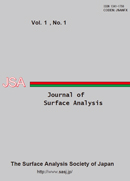
- Issue 3 Pages 187-
- Issue 2 Pages 98-
- Issue 1 Pages 2-
- |<
- <
- 1
- >
- >|
-
Round Robin Test for the Quantification and Standardization of Sample Damage during XPS MeasurementsF. Kurayama, N. Suzuki, M. Sato, T. Furusawa, H. Isahara, Y. Kikuchi, ...2009 Volume 16 Issue 1 Pages 2-11
Published: 2009
Released on J-STAGE: October 20, 2018
JOURNAL FREE ACCESSTo evaluate sample degradation during XPS measurement, a round-robin test involving five laboratories was carried out with four kinds of samples such as cellulose nitrate (NC), polyvinyl chloride (PVC), silicon wafer modified with chloropropyltriethoxysilane (CPTES-Si) and gold substrate modified with 1H, 1H, 2H, 2H-perfluorodecanethiol (PFDT-Au) as model samples. In each sample, the degradation behavior followed first-order kinetics with respect to the relative dose provided by the peak intensity of either Ag 3d5/2 or Au 4f derived from Ag or Au substrates, respectively, as an index of X-ray dose. The result shows that the rank order of the damaging factors of samples was almost the same in each apparatus, but the obtained values were different among the apparatuses. On the other hand, from comparison of Au and Ag substrates for calculating relative X-ray dose, it can be seen that the damaging factors using those two metal substrates are almost equivalent. Considering the convenience in handling and the sputtering process, we concluded that Au substrate is more suitable for an index material to estimate relative X-ray dose. Furthermore, the relative damaging factor RDF, i.e. the damaging factor of each material divided by that of PFDT-Au as a reference material, did not depend on the difference of the apparatuses, and indicated close value for each sample, suggesting that the RDF should have universality and provide an useful information for evaluating sample degradation. Thus, the construction of that database would allow the prediction of the sample degradation by measuring degradation behavior of PFDT-Au as a reference material.
View full abstractDownload PDF (454K)
-
N. Suzuki2009 Volume 16 Issue 1 Pages 12-19
Published: 2009
Released on J-STAGE: October 20, 2018
JOURNAL FREE ACCESSX-ray photoelectron spectroscopy is the technique widely used for the surface analysis of solid materials. In this paper, our XPS measurements of organic thin films such as Langmuir-Blodgett films and self-assembled monolayers on solid surface and the analysis techniques using the spectra are reviewed.
View full abstractDownload PDF (885K)
-
for the Study of Energy Analyzing Systems (13)M. Kato2009 Volume 16 Issue 1 Pages 20-41
Published: 2009
Released on J-STAGE: October 20, 2018
JOURNAL FREE ACCESSThis final chapter describes several aspects of electron optics and its application to electon spectroscopy. An energy-filtering imaging system is presented in the first section. Such a system is realized by incorporating an energy analyzer in a conventional electron microscope, but some crucial optical conditions are required as compared with those in a spectrometer or microscope. Next theme is the equivalence of the optical systems of TEM, SEM, and STEM, which is shown by the theorem of reciprocity. The last section introduces several techniques of numerical calculation for the design of electron optical systems.
View full abstractDownload PDF (3396K) -
J. D. Lee, T. Nagatomi, G. Mizutani, K. Endo2009 Volume 16 Issue 1 Pages 42-63
Published: 2009
Released on J-STAGE: October 20, 2018
JOURNAL FREE ACCESSWe review the history of photoemission electron spectroscopy (PES) from Einstein's photoelectric effect to recent developments and discuss the fundamental principles and central concepts of PES from experimental and theoretical points of view. Further, we briefly introduce recent developments in PES-based experiments, which are important in studying materials science.
View full abstractDownload PDF (1271K)
- |<
- <
- 1
- >
- >|